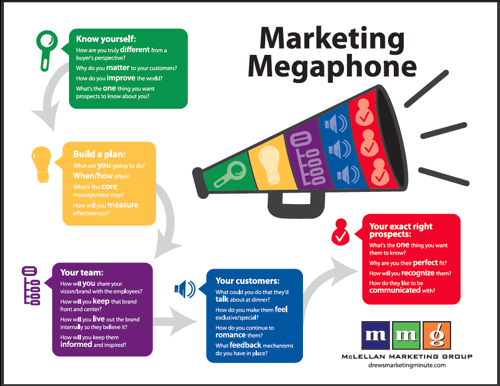August 1, 2012

I spent a few days in Vegas recently and the 24/7 chaos was overwhelming. It’s pure overload for all your senses – tons of people everywhere, driving billboards, TVs in the restrooms, a wide array of smells, and a cacophony of sounds at full volume.
It’s a little like how we’re assaulted by marketing messages every day. Over 5,000 messages a day – aimed at all of our senses, pretty much 24/7.
As consumers — it feels like an attack we have to guard against. As marketers — it’s like a mountain we have to scale.
But somehow our message needs to fight its way to the top and actually be heard. How do we make that happen?
We need a marketing megaphone. (Download 8.5 x 11 version by clicking here) Something that amplifies our message so it gets right where it needs to be.
But that megaphone has to be built in the right order and contain the right elements. Otherwise, it’s just more noise.
Here’s how to construct a marketing megaphone that actually works.
It starts with you: To break through the clutter – you need to be crystal clear about your core messaging. You need to completely understand how you’re different from your competitors, why you matter to your customers and how you can improve their world.
Imagine your voice in the din of over 5,000 messages. You’re whispering and counting on the next layers in the marketing megaphone to magnify your message. So it sure better be the exact right words/sentiment.
Once you know yourself, you need a plan: Marketing doesn’t happen by accident. You need a clear-cut vision for how you’re going to get out the word. Over 90% of businesses operate without a marketing plan and yet they wonder why they have to work so hard for new sales.
A marketing plan eliminates stutter (you hurry up to market when you’re slow and then stop when you get busy, losing all momentum along the way) or inconsistent marketing.
Your inside advantage: One of the most costly mistakes made by companies is that they forget how vital their employees are to their marketing efforts. A team that’s left in the dark can’t possibly help amp up your message. In most cases, they have the contact with your customers and prospects. So why wouldn’t you want them to be completely plugged into your core messaging and your marketing plan for spreading the word?
Be worth bragging about: Another way to turn up the volume in your marketing megaphone is to give your current customers something to talk about. If you delight them or are the kind of organization they’re proud to be associated with – they’ll shout it to the world via their social networks, their in person networks and through referrals.
All too often, we forget to romance them once we actually get the sale. But, by making them feel wanted and special – you not only create recurring revenue at a lower cost of acquisition but you create a legion of cheerleaders, all out there, putting some oomph into that megaphone.
The exact right prospects: One of the key benefits of truly understanding your brand is that you learn who your perfect customers are. You will identify who really needs what you offer and who would be elated to buy it from you. When you have a profile of exactly who that is – you can aim your marketing megaphone right at their ear and not worry about the rest of the world.
Getting heard isn’t easy but with the help of a properly built megaphone, your message can rise above the din and get to the right audience every time.
Want a full-sized jpg for your own? Click here to download one.
More
 Let’s assume the following is true:
Let’s assume the following is true:

















